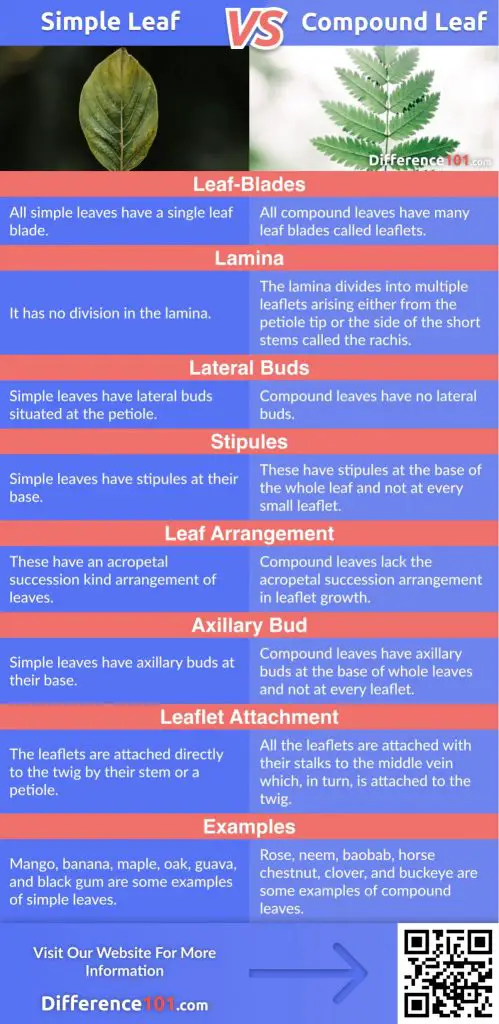The difference between simple vs. compound leaves can be seen in the presence of leaflets. When a leaf is directly attached to a twig without forming any leaflets, it is a simple leaf. However, when a leaf is divided into smaller leaflets, we call it a compound leaf.
Let’s take a closer look at Simple leaf vs. Compound leaf:
| Structure | A simple leaf’s structure is much simpler than that of a compound leaf |
| Leaflets | Compound leaves have leaflets while simple leaves do not |
| Acropetal succession | Compound leaves are not arranged in acropetal succession while Simple leaves are |
| Lamina | Compound leaves have lamina divisions while Simple do not |
Table of Contents
What is a Simple Leaf?
A leaf that forms a single unit without any division in its lamina is called a simple leaf. It is attached to the main stem via petiole. The edges of the leaf can be smooth, lobed, or jagged. A lobed simple leaf will have gaps within the lobes but it is never extended to the midrib.
What is a Compound Leaf?
A leaf that forms several units by creating divisions in its lamina is called a compound leaf. These smaller divisions formed along the midvein of a leaf are known as leaflets. These leaflets have their stalks that are connected to the main stem via rachis.
Simple vs. Compound Leaves Pros and Cons
Simple Leaves Pros and Cons
Pros of Simple Leaves
- They can absorb more sunlight because of the larger surface area.
- They have more stomata openings because of their larger surface area that allows them to exchange useful gases.
Cons of Simple Leaves
- They experience more water loss by evaporation due to their larger surface area.
- They are more prone to damage by strong winds.
Compound Leaves Pros and Cons
Pros of Compound Leaves
- They have greater wind resisting capabilities.
- Lesser surface area results in lesser water loss due to evaporation.
Cons of Compound Leaves
- They absorb less sunlight because of their smaller surface area.
- Smaller surface area means lesser stomata openings that limit the exchange of useful gases.
Compound Leaf vs. Simple Leaf Similarities Explained
- Both simple and compound leaves are found in dicot plants.
- Both simple and compound leaves facilitate photosynthesis.
- Both the leaves contain lamina, stipule, and petiole.
- Both simple and compound leaves display some adaptation to the environmental conditions.
- The margins or edges of both kinds of leaves can either be smooth, jagged, parted, or lobed.
8 Top Differences Between Compound Leaves and Simple Leaves That Must Be Considered
There are some key differences in compound leaves vs. simple leaves that are listed here:
| Basis | Simple Leaves | Compound Leaves |
|---|---|---|
| Leaf-blades | All simple leaves have a single leaf blade. | All compound leaves have many leaf blades called leaflets. |
| Lamina | It has no division in the lamina. | The lamina divides into multiple leaflets arising either from the petiole tip or the side of the short stems called the rachis. |
| Lateral buds | Simple leaves have lateral buds situated at the petiole. | Compound leaves have no lateral buds. |
| Stipules | Simple leaves have stipules at their base. | These have stipules at the base of the whole leaf and not at every small leaflet. |
| Leaf arrangement | These have an acropetal succession kind arrangement of leaves. | Compound leaves lack the acropetal succession arrangement in leaflet growth. |
| Axillary bud | Simple leaves have axillary buds at their base. | Compound leaves have axillary buds at the base of whole leaves and not at every leaflet. |
| Leaflet attachment | The leaflets are attached directly to the twig by their stem or a petiole. | All the leaflets are attached with their stalks to the middle vein which, in turn, is attached to the twig. |
| Examples | Mango, banana, maple, oak, guava, and black gum are some examples of simple leaves. | Rose, neem, baobab, horse chestnut, clover, and buckeye are some examples of compound leaves. |
Comparison Chart

Comparison Video
Simple and Compound Leaves FAQ
What is the Difference between Simple and Compound Leaves?
The difference between simple and compound leaves is found in their formation. Simple leaves form a single unit and are attached to the stem directly. Compound leaves, on the other hand, form multiple units that are connected to the stem through shorter stems.
Why are Some Leaves Compound and Some Simple?
All leaves were once simple leaves. Some leaves evolved with time to become compound leaves to adapt to different environmental conditions. (Ref. 1)
Is Coconut Leaf Simple or Compound?
A mature coconut leaf is a compound leaf forming 200-250 leaflets. However, the first few leaves of a young coconut plant are simple leaves instead of compound leaves. (Ref.2)
Is Papaya a Simple or Compound Leaf?
Papaya bears simple leaves with lobes. (Ref.3)
What are the 3 Types of Leaves?
Three types of leaves are:
- Mesomorphic leaves
- Xeromorphic leaves
- Hydromorphic leaves
What are the Two Types of Compound Leaves?
Two types of compound leaves are:
- Pinnately compound leaves
- Palmately compound leaves
Is Lemon Leaf Simple or Compound?
A lemon leaf is a simple leaf forming a single unit.
What is the Most Common Leaf?
The most common leaves are Mesomorphic leaves that adapt well to a humid climate and abundant water. (Ref. 4)
The Final Words
Simple and compound leaves vary in their structure and appearance. Where a simple leaf forms a single unit without any division in its lamina, a compound leaf is divided into multiple units or leaflets showing multiple divisions in its lamina. Simple leaves are directly attached to the main stem through a petiole. On the contrary, the leaflets of a compound leaf have stalks that are attached to the main stem. Another major difference between the two types of leaves can be seen in their arrangement. Simple leaves display acropetal succession while compound leaves are not arranged in acropetal succession.







